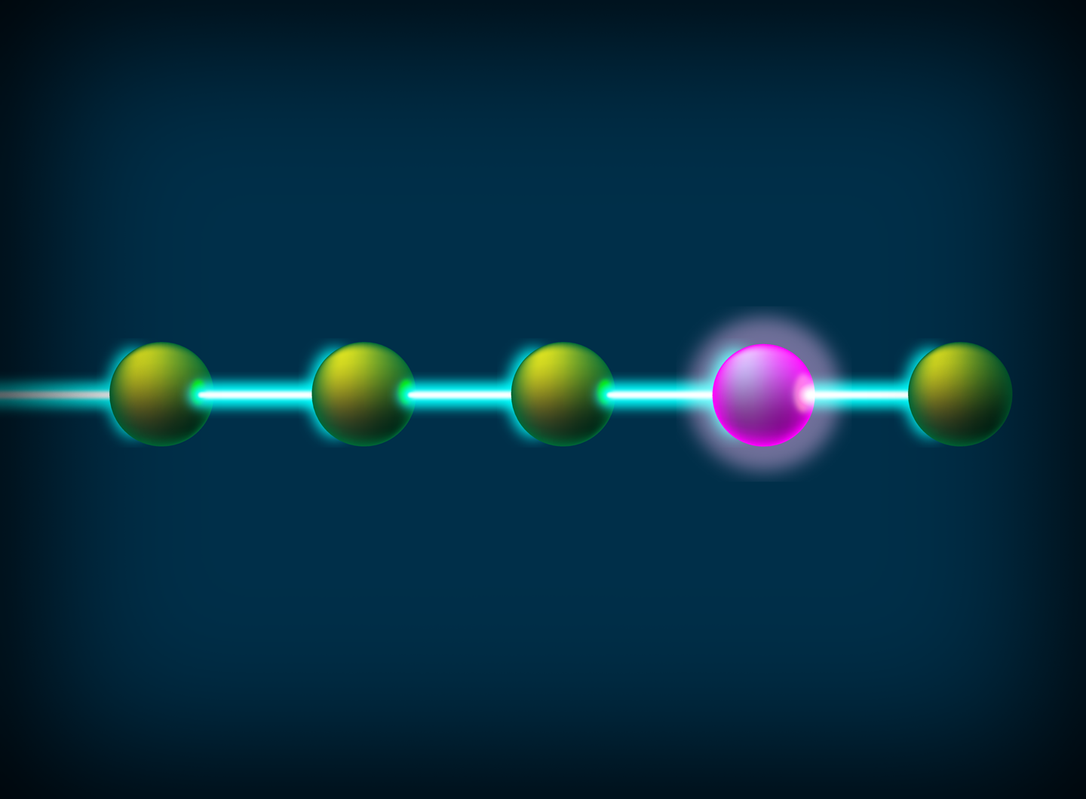Future quantum computers have the potential to solve a wide range of issues. For instance, they could lead to more environmentally friendly materials, new drugs, or even solutions to the most challenging issues in fundamental physics. However, fundamental quantum computers are more error-prone than the conventional computers now in use. Wouldn’t it be convenient if scientists could remove the errors with a special quantum eraser?
 While errors are normally hard to spot in quantum devices, researchers have shown that, with careful control, some errors can cause atoms to glow. Researchers used this capability to execute a quantum simulation using an array of atoms and a laser beam, as shown in this simplified artist’s concept. The experiment showed that they could discard the glowing, erroneous atoms and make the quantum simulation run more efficiently. Image Credit: Caltech/Lance Hayashida
While errors are normally hard to spot in quantum devices, researchers have shown that, with careful control, some errors can cause atoms to glow. Researchers used this capability to execute a quantum simulation using an array of atoms and a laser beam, as shown in this simplified artist’s concept. The experiment showed that they could discard the glowing, erroneous atoms and make the quantum simulation run more efficiently. Image Credit: Caltech/Lance Hayashida
A team of scientists from Caltech is among the first to develop a particular kind of quantum eraser, according to a report in the journal Nature. The researchers demonstrate how “erasure” defects, which can occur in quantum computing systems, can be located and fixed.
It is normally very hard to detect errors in quantum computers, because just the act of looking for errors causes more to occur. But we show that with some careful control, we can precisely locate and erase certain errors without consequence, which is where the name erasure comes from.
Adam Shaw, Study Co-Lead Author and Graduate Student, California Institute of Technology
Quantum computers are founded on physics rules that govern the subatomic domain, such as entanglement, a phenomenon in which particles remain connected to and imitate one another even when they are not in direct touch. The new study focuses on a type of quantum-computing architecture that employs arrays of neutral atoms or atoms with no charge.
They specifically controlled individual alkaline-earth neutral atoms contained within “tweezers” built of laser light. The atoms were stimulated to high-energy levels, sometimes known as “Rydberg” states, in which surrounding atoms began to interact.
The atoms in our quantum system talk to each other and generate entanglement.
Pascal Scholl, Study Co-Lead Author, PASQAL
Quantum computers outperform conventional computers due to entanglement.
Scholl added, “However, nature doesn't like to remain in these quantum entangled states. Eventually, an error happens, which breaks the entire quantum state. These entangled states can be thought of as baskets full of apples, where the atoms are the apples. With time, some apples will start to rot, and if these apples are not removed from the basket and replaced by fresh ones, all the apples will rapidly become rotten. It is not clear how to fully prevent these errors from happening, so the only viable option nowadays is to detect and correct them.”
When erroneous atoms are struck with a laser, the new error-catching technique causes them to fluoresce or light up.
“We have images of the glowing atoms that tell us where the errors are, so we can either leave them out of the final statistics or apply additional laser pulses to actively correct them,” Scholl noted.
Jeff Thompson, a professor of electrical and computer engineering at Princeton University, and his colleagues pioneered the theory for implementing erasure detection in neutral atom systems. That team also just published a study in Nature depicting the approach.
The Caltech team claims that by eliminating and finding flaws in their Rydberg atom system, they can improve the overall rate of entanglement, or fidelity. According to the latest study, only one in 1,000 pairs of atoms failed to get entangled. This is a factor of ten improvement over prior results and the highest-ever measured entanglement rate in this sort of device.
Finally, these findings are encouraging for quantum computing devices that utilize Rydberg neutral atom arrays.
The National Science Foundation (NSF) funded the new Nature study, titled “Erasure conversion in a high-fidelity Rydberg quantum simulator,” through Caltech’s Institute for Quantum Information and Matter (IQIM); the Defense Advanced Research Projects Agency; an NSF CAREER award; the Air Force Office of Scientific Research; the NSF Quantum Leap Challenge Institutes; the Department of Energy's Quantum Systems Accelerator; a Taiwan-Caltech Fellowship; and a Taiwan-Caltech Other Caltech authors include graduate student Richard Bing-Shiun Tsai, Troesh Postdoctoral Scholar Research Associate in Physics Ran Finkelstein, and former postdoc Joonhee Choi, who is now a professor at Stanford University.
Journal Reference:
Scholl, P., et al. (2023) Erasure conversion in a high-fidelity Rydberg quantum simulator. Nature. doi:10.1038/s41586-023-06516-4